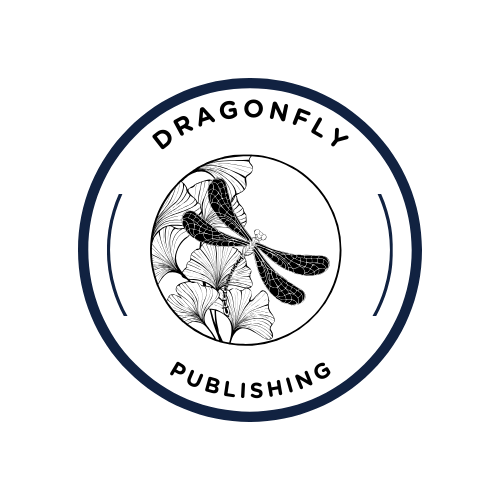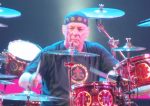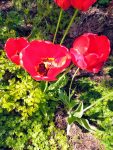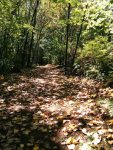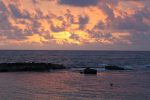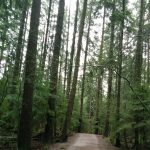I’ve been spending nights curled up in bed, with the sounds of cold rain washing through the cedars outside, reading Neil Peart’s Ghost Rider: Travels on the Healing Road. Though the book is over a decade old now, its relevance is timeless and Neil, the main lyricist–and of course Rush’s great drummer–is a writer to read and listen to. Most people know his lyrics, his kind of profound thoughts. He wrote the memoir of his motorcycle trip on the “healing road” after his daughter died in a car accident and after his wife died later of cancer. It was a time when Rush stopped touring–and it’s admirable that they just waited to see if Neil would be back, for as Geddy Lee said, there was no replacement for him. And everyone seemed to have to stop to deal and cope with such tragedy of their friend.
Neil’s trip took him across Canada, down through the US, and into Mexico and Belize, and back. As I’ve noted often in this blog, nature is a healer. Neil’s story reminds of this, and also, movement helped him to heal, for staying in one place for too long invites ghosts that crowd your space. Because his book is rife with solitude and the charm of wilderness, I am really enjoying it.
I’m at the point now where he is finishing his road trip through Canada and getting ready to head to the United States. From Alaska, he heads down to British Columbia again. I read about his visits to familiar places, where I’ve also stood in complete wonder: Sunshine Coast, Vancouver Island, the Cathedral Grove, and so on. He writes, as he stands in Cathedral Grove, which holds some of the last old-growth trees in the temperate rainforest:
Standing in the muffled gloom under the mighty columns justified the name well enough, for it did feel like a pagan temple to the sanctity of and mystery of Nature. But it was sobering to reflect that, as with the dwindling redwoods and sequoias in California, or the white pines in Ontario, the remaining groves were now rare enough that they each had a name. It was admirable that these remnants had been preserved, of course, but it was depressing to reflect on what they actually represented: all the millions of trees that once shaded the surrounding lands, and most of the continent, and were now gone forever. The ghost forests.
I too have roamed through Cathedral Grove in one of our trips to Tofino (2014), and stood among the giant trees, feeling voiceless, for what could I say that would possibly contribute to their glory in that sanctuary?
Neil went on to head east, back to the mainland, where he visited the haunts we know: The Grouse Grind, for instance. And even further east. He really liked Highway 99, which I remember traveling once when we came back from Kamloops, when I first met Morgan–it goes past Lilooet, where Morgan’s grandma (who will turn 100 in three months) used to live–and it’s a beautiful stretch of road through small towns and isolated mountains and forests. Other towns he mentioned–including 100 Mile House (where we stopped on the way to camping at Loon Bay Resort), and, further, Nelson, Castlegar, Trail, Osooyos, etc.–we’ve been to so often in our trips east to visit Morgan’s family. I love these trips because they are so freeing and beautiful. I have wanted to move to some of these areas of myself–get away from the corrupt housing market and traffic and crowds of Vancouver, though like Neil points out in his book, Vancouver is framed by a beautiful scene: mountains, rainforest, water.
Anyway, I believe in the powers of nature to heal. In the powers of movement. Maybe that’s why I run on trails. I haven’t had a child or spouse die on me, but we each face demons and have to find what helps us to cope. In my case it has been the death of my father, one of the best people I’ve ever known. Then there was the expectation that I would marry a good man who would be a good father/husband like my dad was, but it took me a long time to find that man, and, until that time, I was naively falling for the wrong guys, who abused me both physically and emotionally. Though those ghosts have faded, they did leave me forever jaded in a certain sense. But that also helped me to grow–not without a hell of a lot of travel myself. I had three treks across America and found peace in the Rockies or along rivers or along the western coastlines of California. By the time I made it to Canada, I’d met the man of my dreams.
At night I’ve continued to re-watch “Lost” when I get a chance, and last night, before reading, I watched the episode where Daniel Faraday tells Desmond that the time travel he is experiencing is full of crazy variables all over the board, and he needs to find his constant, which turns out to be Penny, who is there from his past and is still there–which led to the treasured memory of Desmond and Penny talking on the phone when Desmond was on the freighter. It reminded me of constants in my life. If I think of when I was younger, to today; there are just a few constants left: my mother, my sister and brothers, some childhood friends, and, of course, music. One of these constants is Rush, since they were becoming popular around the time I was coming into my own. And so I grew up with their music, and we even went to see them a couple years ago or so when they came to Vancouver. Geddy Lee’s face is so familiar, he seems like an uncle, though of course I have never met him. Alex Lifeson, like a good friend from the bar. Neil Peart like a soul-brother or something. They each formed this amazing band that spoke to millions of people from all over the world, and though we would never meet them personally, they were and are speaking to us.
There was some news recently that Rush was dead, that Neil Peart was quitting music. Turns out that he was not necessarily quitting, just slowing down and no longer touring due to tendonitis in his arms and problems with his shoulders. It’s really weird that I would be reading this book now, as I recently was diagnosed with the same thing. I don’t know why I would have it. I haven’t drummed like a maniac for decades. I’m guessing it is probably from writing a lot, which is sad since I’m working on a new book now–but it really doesn’t bother me when I’m typing, so I don’t know. I do know that it’s very painful. I do my doctor’s recommended 15 reps of three different exercises three times a day, but so far, it seems to be making matters worse. I can barely sleep due to my arms and shoulders seeming to tense up at night, or crack, or just get sore from the position I’m sleeping in. Good thing it doesn’t affect my running, but with this now, and my back, I have learned a new term (common as we age): pain management. Everyone I know with chronic pain uses weed, or some variation of medication. I’m just trying to do stretches that help, or just focus on something else. While Motrin is my friend on some days, I don’t have anything else, and I figure, as it was when I quit smoking over a decade ago, that I will deal with it naturally and just look at it head on and say “that hurts,” and then try to focus on something else.
Thankfully, my legs and feet still seem strong! We are going tomorrow morning to get some trail running shoes for me. I think if I’m going to be running so much on trails, I will need better support, which may help the body core and strength overall. Then I think, since we’ll be in Port Moody, I’ll do a run along the park trail edging the Burrard Inlet there–another area Neil mentioned in his book.
